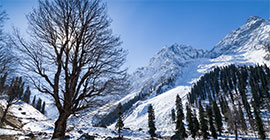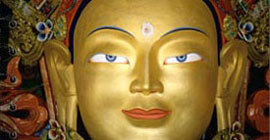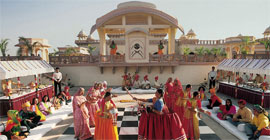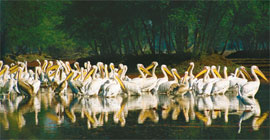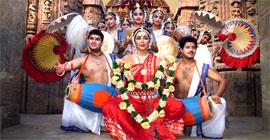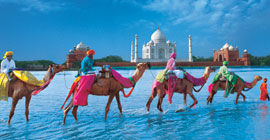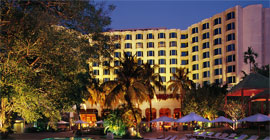Cuttuck
Home | Cuttuck
Cuttack is one of the oldest cities in India and the Commerial Capital of Orissa. It is the second largest city in Orissa.It is situated in a tongue of land formed by the Mahanadi River and its main branch the Kathajodi River at their points of bifurcation in 20.28° N 85.52° E. Its actual is 'Katak'.
Cuttack also known as the "Millennium City", is the cultural capital of Orissa. It lies near Bhubaneswar, Puri and Konark. It is more than a thousand years old (formed in 989 A.D.), and was the capital of Orissa for almost nine centuries, before Bhubaneswar was made the capital city in 1948.Cuttack along with Bhubaneswar are collectively known as the "twin cities" of Orissa. With its world famous unique filigree works in silver, ivory and brass works and textiles of woven silk and cotton, Cuttack is perhaps the grandest showroom of Orissa.
History
Early history of Cuttack is associated with the Keshari dynasty. As stated by the distinguished historian A. Stirling, present-day Cuttack was established as a military cantonment by king Nrupa Keshari of Keshari dynasty in 989 A.D. Stirling based his opinion on Madalapanji, a chronicle of lord Jagannath temple of Puri. The reign of Markata Keshari was distinguished for the stone embank built to protect the new capital from flood in 1002 A.D.
Pithapur, Cuttack
Historical evidence suggests Cuttack becoming capital of a Kingdom founded by Anangabhimadeva of Ganga dynasty in 1211 A.D. After the end of Ganga rule, Orissa passed to the hands of the Gajapati Kings (1435-1541 A.D.) of Solar dynasty under whom Cuttack continued to be the capital of Orissa. After the death of Mukunda deva, the last Hindu king of Orissa, Cuttack first came under Muslim rules and later under Mughals.
By 1750, Cuttack came under Maratha rules and it grew fast as a business center being the convenient point of contact between the Marathas of Nagpur and the English Merchants of Bengal. It was occupied by the British in 1803 and later became the capital of Orissa division in 1816. From 1948 onwards, when the capital was shifted to Bhubaneswar, the city remained the administrative headquarters of Orissa.
Remnants of an old fort called Barabati still exist in the heart of Cuttack with the moat around the fort. Nearby is a modern stadium called the Barabati Stadium, host to many national and international matches.Recently the stadium is updated with flood lights and D/N matches are taking place. Recent growth of the city has resulted in expansion across the river Kathjori and a newer township towards the head of the delta formed between the distributary Kathjori river and the Mahanadi. Cuttack is referred to as a city with Babaan Bazaar, Teppan Galee i.e. a city having 52 markets and 53 streets.
The highest temple of Cuttack is Paramahansa Nath Temple which is situated near Biribati, 14 km away from town. The famous "Katak Chandi Mandir" and "Bhattarika Mandir" adds glory to this Millennium City.
Here is situated a Holy Historical Sikh Shrine "'The Gurdwara Daatan Sahib'". It is here that the first Sikh Guru, Shree Guru Nanak Dev halted on his way to Puri. It is believed that a tree planted by him after using it as a Tooth Cleaner still flourishes here, hence the name Daatan Sahib.
It is noted for having been the birthplace of the prominent Indian statesman, independence leader and freedom-fighter Subhash Chandra Bose. Netaji Subhash Chandra Bose studied in an Anglo till standard 6 which is now known as Stewart and then shifted to Ravenshaw Collegiate of Cuttack.The birth place of Netaji Subhash Chandra Bose which is known as Janakinath Bhawan in Oriya Bazar has now been converted to a museum named as Netaji Birth Place Museum where original letters written by Netaji along with other Netaji's important materials are present in this museum.
Geography
Kathjodi River
Cuttack is located at 20.5° N 85.83° E. It has an average elevation of 37 metres (121 feet). Cuttack is located at the apex of delta formed by the rivers Mahanadi in the north and Kathajodi in the south. The city experiences a hot and humid climate in Summer, characterized by temperature going up as high as above 40 °C and a dry and cold climate in Winter, with mercury dipping to as low as below 10 °C. Summer starts at the end of March, the effect of which is felt till the middle of June when monsoon sets in. Monsoon rains lash the city during September to middle of October and supply most of the city's annual average rainfall of 144.39 cm...
Winter season, between November and beginning of January is characterized by wind chill from north and long nights when sun sets in around 5:30 p.m. IST in December. Winter is not so harsh here.
Between middle of January to the middle of March, the climate is pleasant with temperatures ranging a minimum of 22.2 °C and a maximum of 33.4 °C, which is ideal to visit the city.
Demographics
As of 2001 India census, Cuttack had a population of 535,139. Males constitute 53% of the population and females 47%. Cuttack has an average literacy rate of 75%, higher than the national average of 59.5%: male literacy is 80% and, female literacy is 69%. In Cuttack, 10% of the population is under 6 years of age.
Transport
It lies on the national highway no. 5, connecting Kolkata and Chennai. Well connected by rail, it is an important hub for most trains. The nearest airport is Biju Patnaik Airport, which is 28 km away. It also has the largest bus terminus of the state.
An Indian Air Force Airport is also present in Charbatia at Cuttack.
Festivals
Goddess Chandi
Goddess Mangala
Orissa has several festivals. All those festivals are celebrated in a grand way at Cuttack. But the Unique festivals of Cuttack are Dusshera and Baliyatra. Dusshera is the festival of goddess Durga. It is celebrated with much fanfare throughout the city. Cuttack is famous for its chandi medha, which are basically silver filigree works. Huge amount of gold and silver is used in the construction of these medhas. Baliyatra is the festival of remembering the ancient tradition of trade between Orissa and Java, Bali and Sumatra. It is held every year in the month of November. Among other celebrations the Kite flying festival is very much attractive. It is held in the month of January.







